It’s a great feeling once you finish a painting which you have long worked on and you are satisfied with the result. But your work does not finish there. There are a number of tasks which I recommend you do once you finish a painting.
These tasks may not provide any immediate benefit, but let me assure you, you will be glad you did them later down the track when all your paintings are nicely recorded, organized and maybe even sold. So here is a quick checklist for some of the things you should do after you finish a painting.
In this post, I cover:
- 1. Consider if It Is Actually Finished
- 2. Sign Your Painting
- 3. Name Your Painting
- 4. Photograph Your Painting
- 5. Record the Details
- 6. Clean up the Edges
- 7. Does It Need Varnishing?
- 8. Update Your Website
- 9. Create a Blog Post or Video About Your Painting
- 10. List Your Painting for Sale on Online Market Places
- 11. Search for Upcoming Competitions to Submit Your Painting To
- Want to Learn More?
- Thanks for Reading!
1. Consider if It Is Actually Finished
Knowing when to put the brush down and calling it finished is a skill on its own. There are many times when I have considered a painting finished, only to get the paints out again, later on, to fix up something that was annoying me or an error which revealed itself.
So before you run through the rest of the checklist, I suggest you place the painting somewhere clearly visible in your house where you can see the painting from many different perspectives (don’t place it in a narrow hallway where you can only see it up close) and then wait.
If you are satisfied with the painting after a few days or even weeks, then I would consider it complete.
2. Sign Your Painting
Signing your painting should be the last time your brush touches that canvas. Of course there will be times when you need to fix something up, but in general, your signature should be your last stroke.
Your signature almost provides a sense of closure and relief that you made it to the end of the painting and you feel it deserves your signature. This is a big achievement and you should take pride in signing every finished painting.
I wrote more about signing your painting here.
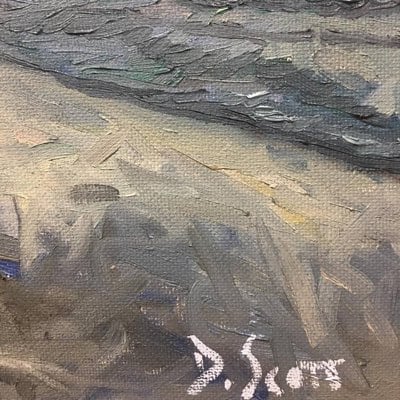
3. Name Your Painting
You don’t need to get all deep and meaningful with your naming. It could merely describe what you have painted. That is how I have named most of my paintings.
I don’t think the name should matter all that much. If you did a good job, then your painting should say enough without the name. Though many of those famous abstract paintings which don’t seem to have a lot going on would probably be meaningless without a name – just another black stripe on a canvas.
4. Photograph Your Painting
This topic deserves an entire post.
Photographing your painting will feel like it is the bane of your existence as an artist. I guarantee your photos will often turn out:
- Too light/dark
- Too cool/warm
- Not clear enough
- With parts cropped out
Once you have a process in place which includes proper lighting and a decent camera, then you should be able to consistently take proper photos of your paintings. But getting to this level is no easy task. I wrote about this process in detail here.
It is extremely important that you learn how to photograph your art as that is the only way to ensure some form of your art lasts forever. Photography is a fantastic luxury for us artists so learn to embrace it.
Thankfully I have my assistant Kobe to always help with photographing my paintings.
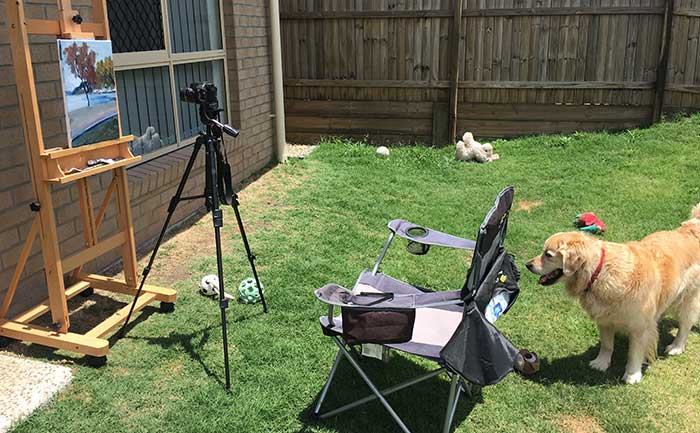
5. Record the Details
Whilst it may not seem important now, it is very useful to have a list which records the name, dimensions, medium, date and sold status of all your paintings. This way you can easily monitor your productivity as an artist and keep track of all your paintings.
This becomes increasingly important once you start to build a sizable body of work.
6. Clean up the Edges
If your painting is on gallery stretched canvas and you did not extend the painting over the edges, then you may want to consider what you are doing with the edges. You don’t want to wait until the painting is sold before you think about it.
Here are your options:
- Do nothing and leave the edges looking somewhat untidy (see the photo below). This is fine if your painting is going to be framed.
- Paint over the edges with white or black paint. This is a good option if you do not intend for the painting to be framed. You could also tape the edges before you start painting then remove the tape at the end, leaving a crisp white edge.

7. Does It Need Varnishing?
If you are using oil paints, then you will need to wait for the paint to dry completely before you can varnish it. This could take anywhere from a few months to a year. If you are painting in acrylics, you could varnish much sooner.
Varnish will protect your painting by stopping dirt and debris from getting into the paint. The varnish can be removed at a later date if the painting needs some restoration.
Varnishing your paintings is optional. Some artists decide not to varnish as it can change the way the finished painting looks.
8. Update Your Website
If you have an art website, now is the perfect time to update it with your latest painting. Be sure to use a high-quality photo which has been optimized for the web. Unoptimized photos straight from your camera will look great but tend to be very large and will slow your website down. So you need to balance the appearance with website performance.
On your website make sure you document the name, dimensions and date of the painting.
9. Create a Blog Post or Video About Your Painting
If you run an art blog or Youtube channel then your painting process and the finished painting could provide great content for these platforms. You could discuss your finished painting, the challenges you faced, your processes and your overall thoughts.
People enjoy seeing the process of creating just as much as they enjoy the finished product. Even if you are just learning, there are people around the world who will appreciate your thoughts.

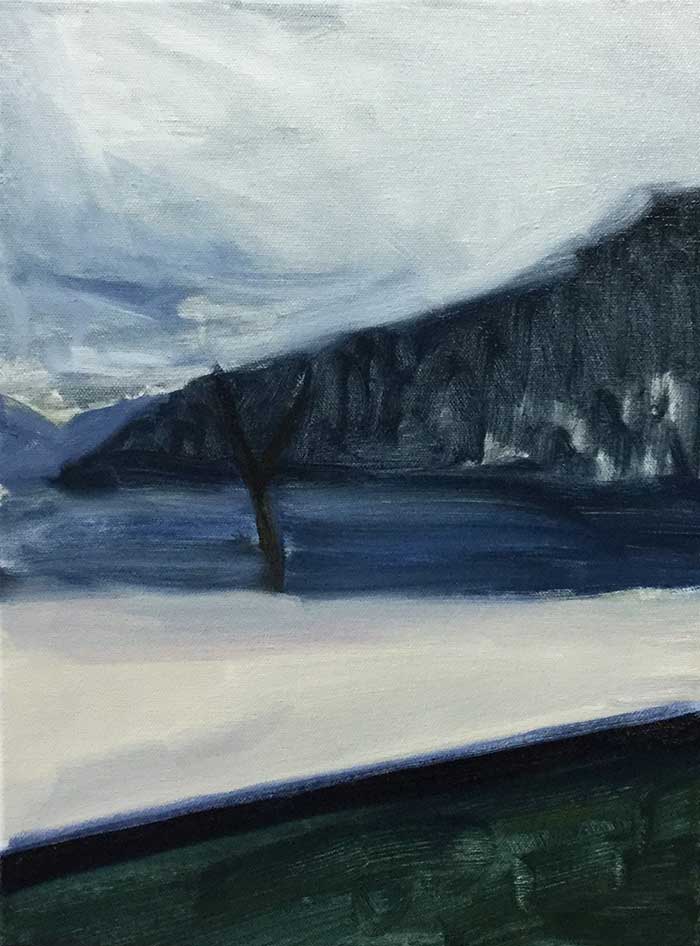

10. List Your Painting for Sale on Online Market Places
There are many online art marketplaces which you can list your paintings for sale for a commission (usually around 30%). Some of these marketplaces will even arrange a courier on sale.
You get exposure to thousands of viewers, but you will be competing with many other artists so do not expect too much from these platforms. Use them to complement your overall marketing strategy rather than rely on them.
You can also upload high-quality photos of your painting and sell prints via these platforms without having to arrange anything. Your success in this area will really depend on the demand for your kind of art. Some art just seems to perform better in the mass market.
11. Search for Upcoming Competitions to Submit Your Painting To
If I am really pleased with the finished painting, then the last thing I will do is search for any upcoming competitions to which I could submit my painting. Submitting a painting to competitions is time-consuming so be selective with what competitions you try to enter and make sure your painting suits the competitions. For example, if you just finished a beautiful impressionist landscape painting, then don’t try and enter that painting into an abstract contemporary art competition.
Want to Learn More?
You might be interested in my Painting Academy course. I’ll walk you through the time-tested fundamentals of painting. It’s perfect for absolute beginner to intermediate painters.
Thanks for Reading!
I appreciate you taking the time to read this post and I hope you found it helpful. Feel free to share it with friends.
Happy painting!
Dan Scott

Draw Paint Academy

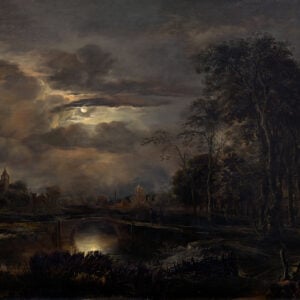
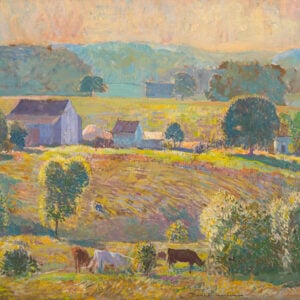
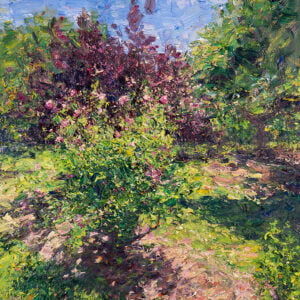
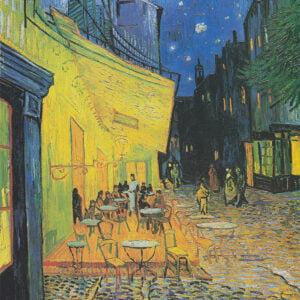
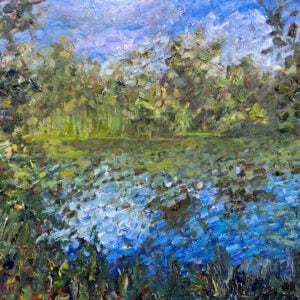
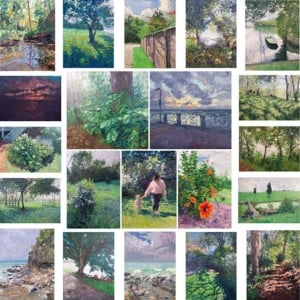
Most of my paintings are copies of ones I see. I do have a few original ones that I am pleased with but like many amateurs mine are all stacked in a closet. They are never good enough to show but I do give them away a great deal.
Wow! That sounds just like me. I do the same things.
That’s exactly what I do. !!
I do not really copy but use original ones I see for inspiration. I take a pic and put them on my sites. Just because I can and I enjoy seeing the progress made. Then they end up in the closet. Lol.
I’ve been painting for a short time and do the same thing.
Same here. I’ve done some original ones but I get most of my inspiration online. Sometimes I incorporate elements of two or more images, either paintings or photos, that I find online. I’ve never felt any of mine are good enough to show – I’m a beginner who’s only been painting for 6 months – and I’m a harsh critic of my work – but my daughters, sister, and brother like them and have them hanging on their walls. Just last week I decided to hang some of the paintings that, like you, I had stacked and out of sight.
Me two
Same story here 😂😭
Looking forward to your blog about photographing your artwork! Thanks for these helpful tips! I’m glad to know I’m not alone in working on a “finished” piece!
Thank you Dan. This is a great blog, I get a lot out of it and not only read it fully but I also keep them all for future reference! Carolina
I’m missing a 12th step; what if you want to frame the picture? I loved the article, though, and will share it on our page!
Thank you very much ,it is a very useful article
Thanks for your post. I’m no professional but I bring my paintings around the edges of the canvas and find this gives a nice effect too.
Me too!
Hi Dan and thank you for this post. I’ve only been painting for 6 months (acrylics) and have gleaned a lot of great tips and information from your posts. From the start I didn’t like the unfinished edges so I’ve either painted in a complimentary color or brought the painting around the edges. My first painting was a simple birch tree scene using masking tape and an old credit card. The project appeared in my Pinterest feed one day in late May and I decided to give it a go. Little did I know this simple project was going to lead to anything else but since that day I’ve been rather obsessed and have nearly 30 paintings under my belt. All are clearly in the ‘beginner’ category but I’m seeing little improvements in skill with each painting. Oh, and I’ve kept a photographic record of each painting in a dedicated folder on my phone and laptop. Also, stepping away from a painting for a few days or weeks is something I hadn’t considered. Again, thanks for this very helpful post!
I’m eager to learn what you will advise us to do to capture the “perfect” photo. I have wasted countless hours on this! Please suggest tips for outside as well as indoor photography, Also include what to do if you don’t have a tripod, how to secure a painting so the wind doesn’t get in it (or pollen), how to get the painting to sit upright or the angle of your camera, etc. I appreciated your post and hope to see more articles.
Thanks Dan. very helpful. If the work is plein air I try to remember to take a photograph the scene including in the painting on easel clearly in the foreground for provenance sake. I do sometimes forget!
Thanks Chris! Dan
I am an old oil- on- canvas painter who has exhibited in many cities around the world but I am learning everything afresh from scratch now because a) I had to leave painting for several years, b) I felt disillusioned by the extent of disregard for method, rigor and standards and c) I feel quite rusty and uninformed. Your piece above, I find particularly lucid and well structured. I am encouraged and I want to thank you for it.
Thank you Dan for your posts. I’m very glad that I found your site and I constantly read your tips and lessons that I find very useful for myself as a beginner. I worked intensively for the first time and took a part in local exhibitions, but now I decided to analyze my work more carefully and pay more attention to the theory, and apply it in a my small paintings, so as I not lose my painting skills. And your advises help me very much, thank you for sharing your experience.
Hi Larissa. Thanks for your kind words and glad you find the posts useful! Dan
I always find your blog most helpful. I like your ideas for photographing your work. I would find some information about glazes most helpful
Thanks Gina! Glad to help. I will try adding some information about glazes shortly.
Dan, thanks for the great tips! I appreciate your posting. One of the things I fail to remember to do is get pictures during the process, but fortunately I have a hubby who is always reminding me 🙂 I look forward to your post on photographing. That is one thing I would like to work on.
I am an amateur painter who likes all your tutorials but don’t exhibit my paintings as I feel I am not good enough.I sometimes gift a few &hope they will not be thrown away .Thank you for your valuable tips
Jayashri Kurup
I also gift many of my paintings….It is such a pleasure to give away to someone I care about a part if myself.
Dan, how do you rejuvenate your excitement for painting when you feel burned out? I try to hit museums when I can, but us there a painting technique like throwing paint on a canvas to see what happens, etc? I know if an old parlor game that was used in the 20’s called Exquisite Corpse. I have tried that as well. Open to suggestion to keep the creative juices flowing. Thank you!
Hi Loretta. I like to research master artists. That usually gives my inspiration a good spark.
Dan
First, Let me just extend my appreciation to Dan Scott for posting this blog. Clearly, a lot of thought and care has gone into it and the content is helpful in variety of ways.
Second, in response to so many respondents who are concerned about the quality of their work, you should know that will likely always be the case. All of us will always believe and want to do better work. That being said; maybe a short and simple philosophy or plan might be helpful. It is simply, make as much art as you are able so long as you are experiencing personal joy and growth from doing so. Also, surround yourself with people, in-person or on-line that you can mutually share your art-making experience. Last, continue to experiment without inhibition. Live and enjoy the process and make art for your sake. Everything thereafter if a plus.
One other note in regard to creating art and promoting your work. Finding a niche and branding yourself is part of the art industry and yes I committed a perceived blasphemy by using employing the word “industry”. It is OK to promote both yourself as an artist and your work as well. Rembrandt did it, Gauguin did it and so did more recent artists like Picasso, Matisse, Rivera, Duchamp, Magritte, Basquiat and Dali. I doubt that many of you haven’t heard of Toma Kincade – “Painter of Light”. Now that is self-promotion and the promotion of one’s art. I disdain the term; “amateur artist”. If you make art, you are an artist. Enjoy the process, make art for your sake and be bold about and share your enjoyment with others.
Hi Dan, thanks for the kind words and fantastic advice! Really appreciate it. Dan
Wonderful advice. I have watercolor paintings up to 12 feet in length and people will ask me what am I going to do with them. My response is always I just paint for myself. Passion for the work drives me, not creating a sale. The challenge of constantly pushing the boundaries of the medium stimulates my curiousity. I always start a new piece with the question; Why am I painting this?
Thanks Wally!
My eight year old granddaughter says she wants to be an artist when she grows up and I’ve told her those exact same words. “If you make art, you are an artist.” She lights up like sunshine and inspires me.
Very encouraging to think of yourself as an artist and I will stop saying amateur artist. I have not even thought about promoting my art but maybe someday.
Sounds good! Dan
Oh! I love this! It’s what we artists need to read & remember. Every bit you’ve offered is music to my ears. I feel exactly like the people commenting to Dan. I do exhibit my work, but cautiously. I’m compelled to explain my art. I’ve only given 2pcs. away bc I’m afraid they’ll toss it at first chance. My art is a part of me & who I am, like my children.
Find out if there is a local art league to join in your area. Ours is a wonderful group that consists of professionals, serious hobbyists, beginners, painters and photographers. We have two member shows a year, annual paint-outs and many opportunities to display art in community businesses and to enter work in participating galleries or competitions. We have work in progress critiques and members give helpful advice in all areas of technique and marketing. We also have five monthly meetings a year and many of those feature speakers who are artists in our city.
Thanks Kathleen, great suggestion!
Thaankuh so much! Quite inspirational!
Glad that i found your page!
Thank you for your posts. I had a friend who told me when I began to take pictures of my painting at different stages. That has been helpful to see where I started.
Your list, especially 1-7, provide a great final check list. I have recorded every painting I’ve done, and taken a photo which I keep in a separate album. Each painting is numbered as is the photo of it, so I can instantly match them up with with the record I have on file.
Thanks for your helpful hints. Following them really make a difference in presenting a “professional” piece of art.
That’s great Nancy, keep up the good work! Thanks, Dan
This is a very useful and good blog. I am an amateur painter, painting is my hobby. I often try to emulate the paintings I like. Thanks for useful tips.
No problem! Thanks, Dan
I thought it was super interesting that you said it was important to learn when your painting is finished and that setting it in a place in the house where you can see it from many different angles will help you know if it’s really done. Personally, I think this would also allow other people to see it, and if they’re honest and really good friends, they can point out some things that they don’t understand or think are errors. I will have to look for a good painting workshop to learn more about how to improve my talents and evaluate when my paintings are finished.
Very true David! Sounds good. Dan
That is a good point that signing your painting should be the last time your brush touches the canvas. Maybe it would be good to remember that if I were to go to a painting studio. Then I would be able to have the final touches added to my canvas painting.
Thank you Dan for useful tips!
Dan, great tips! Regarding #4: I do watercolors and have been scanning them rather than photographing them. What are your thoughts on that?
Amazing space for artists! Keep creating your masterpieces!
Dan, truly care about others!
All the best to you and wishing you continued success!
Happy Holidays!
Hallo Dan. Köszönöm, hogy rád találtam és élvezhetem bátoritó szavaid. A festés számomra olyan kikapcsolódás, ami nem hasonlitható semmi máshoz. Élvezet a szó legmélyebb értelmében. Szeretnék küldeni neked fotót néhány munkámról. Internetröl veszem a témáimat, Kezdö de igen szenvedélyes ecsetkezelö vagyok. Föleg olaj és vászon a kedvenceim. Tisztelettel
Elisabeth Jung
IKEA sells inexpensive picture ledges. I have two that I use to display paintings. I leave them up for a while and things catch my eye as I’m going by. This gives you some distance both emotionally and physically to critique them. Rather than framing or hanging it’s an easy way to put painting on display. And it’ great to change them seasonally.
Once you get to painting several paintings a day, the finishing process gets pretty abrupt! I keep just one record of my paintings, and that is my website. As long as you keep a backup you have a record that can be converted into any other format (make sure you backup the database for the text, date, title, etc.).